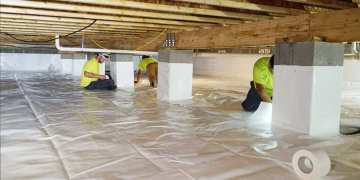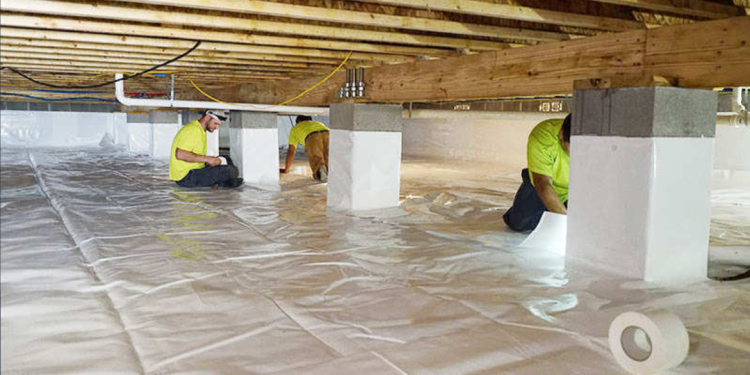Are you tired of dealing with a damp and musty basement? Look no further! In this article, we will explore the world of basement waterproofing solutions, helping you achieve a dry and comfortable living space.
Identifying the source of moisture is crucial in addressing your basement’s water problems. We will guide you through the process, ensuring that you understand how to locate and eliminate any potential leaks.
From exterior waterproofing methods to interior techniques, we will cover all the bases. Learn about effective strategies such as installing drainage systems, applying sealants, and using vapor barriers to keep water out.
Additionally, we will delve into the importance of sump pump systems in maintaining a dry environment. Discover how these systems work and why they are essential for preventing flooding.
By following our advice on maintenance practices, you can maintain a consistently dry basement year-round. Say goodbye to water damage and hello to a drier living space!
Identifying the Source of Moisture
You need to figure out where the moisture is coming from in your basement so you can find the right waterproofing solution. Start by inspecting the walls and floors for any signs of water intrusion or leaks. Look for damp spots, discoloration, or peeling paint, as these may indicate a problem area. Next, check the exterior of your home for any potential sources of water entry such as clogged gutters or downspouts, improper grading, or cracks in the foundation. Additionally, examine your plumbing system to ensure there are no leaks or condensation issues. If you’re unable to identify the source on your own, it’s recommended to consult with a professional who specializes in basement waterproofing. Identifying the source of moisture is crucial in order to implement an effective waterproofing solution and prevent further damage to your basement.
Exterior Waterproofing Methods
Explore the various methods available for keeping your basement protected from water damage on the outside of your home. Exterior waterproofing is an effective way to prevent water from seeping into your basement through the foundation walls. One common method is applying a waterproof membrane or coating to the exterior walls. This creates a barrier that prevents water from penetrating into the basement. Another option is installing exterior drain tiles, which act as a drainage system around the perimeter of your home. These tiles collect and divert water away from the foundation. Additionally, you can consider adding a sump pump to remove any excess water that may accumulate around the foundation. By implementing these exterior waterproofing methods, you can ensure that your basement remains dry and free from moisture-related issues.
Interior Waterproofing Techniques
Consider using interior waterproofing techniques to effectively protect your basement from water damage. Interior waterproofing methods focus on managing water that has already penetrated the foundation walls or is entering through cracks and gaps. Here are three effective techniques to consider:
- Install a sump pump: A sump pump collects water that accumulates in a pit and pumps it away from your basement, preventing flooding. Choose a model with a battery backup for uninterrupted operation during power outages.
- Use interior drainage systems: These systems include perforated pipes installed along the perimeter of the basement floor, which collect water and direct it towards the sump pump. This helps keep your basement dry by effectively managing groundwater.
- Apply waterproof coatings: Waterproof coatings can be applied to the interior walls and floors of your basement to create a barrier against moisture intrusion. These coatings prevent water vapor transmission and help maintain a dry environment.
By implementing these interior waterproofing techniques, you can ensure a dry and protected basement free from water damage.
Installing a Sump Pump System
When it’s time to tackle the issue of water damage in your basement, installing a sump pump system will give you peace of mind and protect your home from flooding. A sump pump is a device that is designed to remove excess water from the lowest point in your basement, known as the sump pit. The system works by collecting water through drains or waterproofing channels and then pumping it away from your home’s foundation.
To install a sump pump system, start by excavating a hole in the floor of your basement to create the sump pit. Place a liner in the hole to prevent water from seeping into the surrounding soil. Next, connect PVC pipes to direct the collected water away from your home. Install a check valve on one of these pipes to prevent backflow into the pit. Finally, install the actual sump pump inside the pit, making sure it is securely placed on top of bricks or gravel for proper drainage.
A properly installed and maintained sump pump system can be an effective solution for keeping your basement dry and preventing costly water damage to your home.
Maintaining a Dry Basement
One key aspect of ensuring a secure and protected home is by properly maintaining your basement to prevent any potential water damage. Regular maintenance is crucial to keep your basement dry and avoid costly repairs. Start by inspecting the exterior of your home for any cracks or gaps that could allow water to seep into the basement. Seal any openings with waterproof caulk or epoxy. Inside the basement, check for signs of moisture such as damp walls or musty odors. If you find any issues, address them promptly to prevent further damage. Keep the humidity level in your basement low by using a dehumidifier or installing a ventilation system. Make sure all gutters and downspouts are working properly to direct water away from your foundation. By following these maintenance tips, you can ensure a dry and safe basement for years to come.
Conclusion
In conclusion, by identifying the source of moisture and implementing effective basement waterproofing solutions, you can ensure a dry and secure environment for your home. Exterior waterproofing methods such as installing drainage systems and applying sealants can prevent water infiltration from outside. Interior techniques like using waterproofing coatings and installing vapor barriers offer additional protection against moisture. Installing a sump pump system can effectively remove any accumulated water, while regular maintenance will help to maintain a dry basement in the long run. By taking these measures, you can successfully protect your basement from water damage.

























